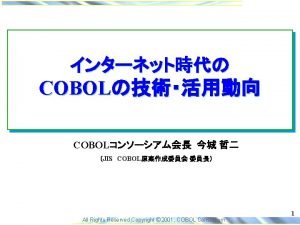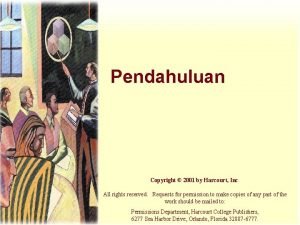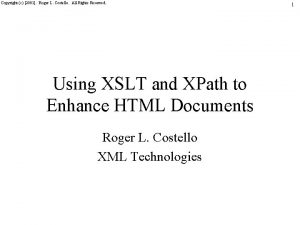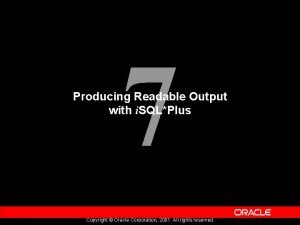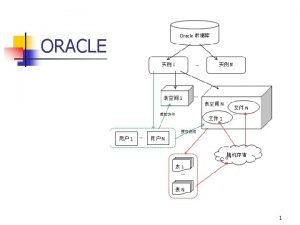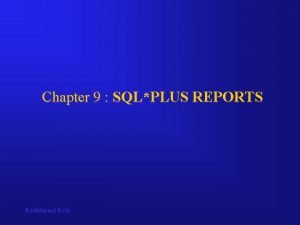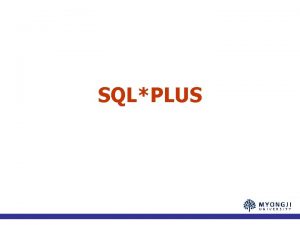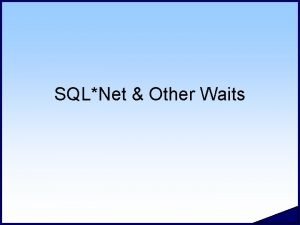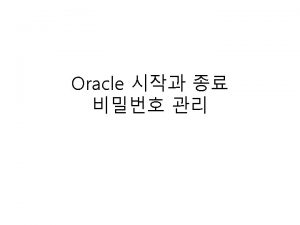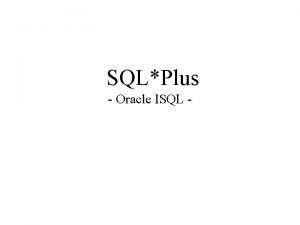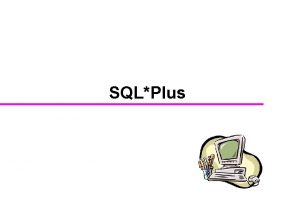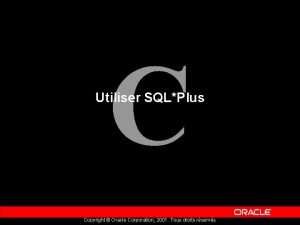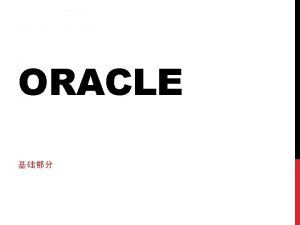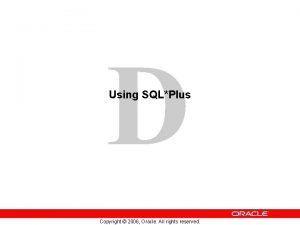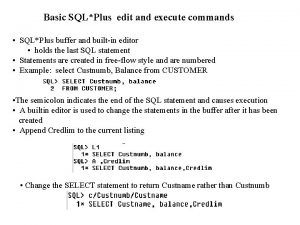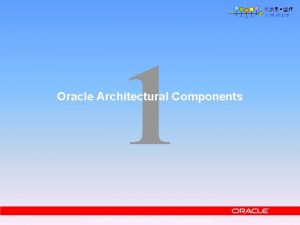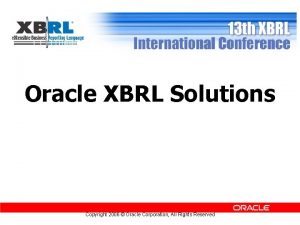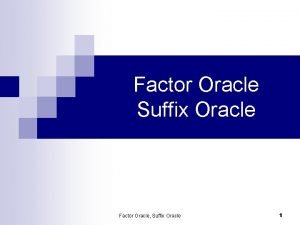C Using SQLPlus Copyright Oracle Corporation 2001 All








![SQL*Plus Editing Commands • • C-9 A[PPEND] text C[HANGE] / old / new C[HANGE] SQL*Plus Editing Commands • • C-9 A[PPEND] text C[HANGE] / old / new C[HANGE]](https://slidetodoc.com/presentation_image_h2/b2a706a657727472c9d3ac07d97ed226/image-9.jpg)
![SQL*Plus Editing Commands • • • C-10 I[NPUT] text L[IST] n L[IST] m n SQL*Plus Editing Commands • • • C-10 I[NPUT] text L[IST] n L[IST] m n](https://slidetodoc.com/presentation_image_h2/b2a706a657727472c9d3ac07d97ed226/image-10.jpg)





- Slides: 15

C Using SQL*Plus Copyright © Oracle Corporation, 2001. All rights reserved.

Objectives After completing this appendix, you should be able to do the following: • • C-2 Log in to SQL*Plus Edit SQL commands Format output using SQL*Plus commands Interact with script files Copyright © Oracle Corporation, 2001. All rights reserved.

SQL and SQL*Plus Interaction SQL statements Server SQL*Plus Query results Buffer SQL scripts C-3 Copyright © Oracle Corporation, 2001. All rights reserved.

SQL Statements versus SQL*Plus Commands SQL • A language • ANSI standard • Keywords cannot be abbreviated • Statements manipulate data and table definitions in the database SQL statements C-4 SQL buffer SQL*Plus • An environment • Oracle proprietary • Keywords can be abbreviated • Commands do not allow manipulation of values in the database SQL*Plus commands Copyright © Oracle Corporation, 2001. All rights reserved. SQL*Plus buffer

Overview of SQL*Plus C-5 • • • Log in to SQL*Plus. • • Execute saved files. Describe the table structure. Edit your SQL statement. Execute SQL from SQL*Plus. Save SQL statements to files and append SQL statements to files. Load commands from file to buffer to edit. Copyright © Oracle Corporation, 2001. All rights reserved.

Logging In to SQL*Plus • From a Windows environment: • From a command line: sqlplus [username[/password [@database]]] C-6 Copyright © Oracle Corporation, 2001. All rights reserved.

Displaying Table Structure Use the SQL*Plus DESCRIBE command to display the structure of a table. DESC[RIBE] tablename C-7 Copyright © Oracle Corporation, 2001. All rights reserved.

Displaying Table Structure SQL> DESCRIBE departments Name -----------DEPARTMENT_ID DEPARTMENT_NAME MANAGER_ID LOCATION_ID C-8 Null? Type -----------NOT NULL NUMBER(4) NOT NULL VARCHAR 2(30) NUMBER(6) NUMBER(4) Copyright © Oracle Corporation, 2001. All rights reserved.
![SQLPlus Editing Commands C9 APPEND text CHANGE old new CHANGE SQL*Plus Editing Commands • • C-9 A[PPEND] text C[HANGE] / old / new C[HANGE]](https://slidetodoc.com/presentation_image_h2/b2a706a657727472c9d3ac07d97ed226/image-9.jpg)
SQL*Plus Editing Commands • • C-9 A[PPEND] text C[HANGE] / old / new C[HANGE] / text / CL[EAR] BUFF[ER] DEL n DEL m n Copyright © Oracle Corporation, 2001. All rights reserved.
![SQLPlus Editing Commands C10 INPUT text LIST n LIST m n SQL*Plus Editing Commands • • • C-10 I[NPUT] text L[IST] n L[IST] m n](https://slidetodoc.com/presentation_image_h2/b2a706a657727472c9d3ac07d97ed226/image-10.jpg)
SQL*Plus Editing Commands • • • C-10 I[NPUT] text L[IST] n L[IST] m n R[UN] n n text 0 text Copyright © Oracle Corporation, 2001. All rights reserved.

Using LIST, n, and APPEND SQL> LIST 1 SELECT last_name 2* FROM employees SQL> 1 1* SELECT last_name SQL> A , job_id 1* SELECT last_name, job_id SQL> L 1 SELECT last_name, job_id 2* FROM employees C-11 Copyright © Oracle Corporation, 2001. All rights reserved.

Using the CHANGE Command SQL> L 1* SELECT * from employees SQL> c/employees/departments 1* SELECT * from departments SQL> L 1* SELECT * from departments C-12 Copyright © Oracle Corporation, 2001. All rights reserved.

SQL*Plus File Commands • • C-13 SAVE filename GET filename START filename @ filename EDIT filename SPOOL filename EXIT Copyright © Oracle Corporation, 2001. All rights reserved.

Using the SAVE and START Commands SQL> 1 2* SQL> L SELECT last_name, manager_id, department_id FROM employees SAVE my_query Created file my_query SQL> START my_query LAST_NAME MANAGER_ID DEPARTMENT_ID -------------King 90 Kochhar 100 90. . . 20 rows selected. C-14 Copyright © Oracle Corporation, 2001. All rights reserved.

Summary Use SQL*Plus as an environment to: • • C-15 Execute SQL statements Edit SQL statements Format output Interact with script files Copyright © Oracle Corporation, 2001. All rights reserved.
 Copyright 2001
Copyright 2001 Copyright 2001
Copyright 2001 Copyright 2001
Copyright 2001 Copyright (c) 2001-
Copyright (c) 2001- Copyright 2001
Copyright 2001 Copyright 2001
Copyright 2001 Sqlplus format output
Sqlplus format output Set headsep
Set headsep Sqlplus report formatting
Sqlplus report formatting Sqlplus quit
Sqlplus quit Ixxx
Ixxx Name a point that is collinear with the given points
Name a point that is collinear with the given points Microsoft corporation. all rights reserved.
Microsoft corporation. all rights reserved. Microsoft corporation. all rights reserved.
Microsoft corporation. all rights reserved. Microsoft corporation. all rights reserved
Microsoft corporation. all rights reserved Microsoft corporation. all rights reserved
Microsoft corporation. all rights reserved
